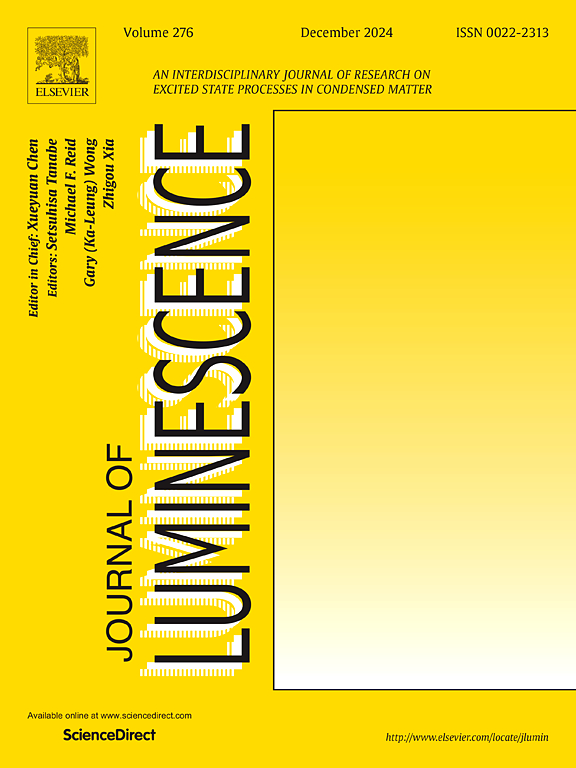Yb3+/ Er3+ co-doped KBaGd(MoO4)3 luminescent materials: structure, UC luminescence and optical thermometry
IF 3.6
3区 物理与天体物理
Q2 OPTICS
引用次数: 0
Abstract
Developing high-performance rare earths activated luminescent materials for optical thermometer and other display devices has been a prominent research topic. This study utilized a conventional solid-state method to prepare KBaGd(MoO4)3: Yb3+, Er3+ phosphors. A comprehensive analysis of the structural characteristics, morphological features, and emission spectrum behaviors was conducted through XRD, SEM, and fluorescence spectroscopy measurements. Upon 980 nm excitation, the obtained samples displayed pronounced up-conversion (UC) luminescence characteristics, featuring characteristic green (530/552 nm) and red (670 nm) emission bands corresponding to Er3+ transitions. Employing the distinct thermal responses of Er3+ Stark sublevels, a monocentric optical thermometer was developed through FIR analysis of thermally coupled transitions (2H11/2/4S3/2 and 2H11/2/4F9/2), enabling dual-channel non-contact temperature detection within a unified emitter system. This phosphor possessed Sr-max of 2.15 % K−1@298K and Sa-max of 2.04 % K−1@573K. More importantly, the phosphor exhibited excellent thermal stability, which is beneficial for achieving high-precision temperature measurements. Experimental evidence confirms the Yb3+/Er3+ co-doped KBaGd(MoO4)3 phosphor with exceptional thermometric performance has potential applications in the field of optical temperature sensing.
Yb3+/ Er3+共掺KBaGd(MoO4)3发光材料:结构、UC发光及光学测温
开发用于光学温度计和其他显示器件的高性能稀土活化发光材料一直是一个突出的研究课题。本研究采用传统的固态法制备KBaGd(MoO4)3: Yb3+, Er3+荧光粉。通过x射线衍射(XRD)、扫描电镜(SEM)和荧光光谱(fluorescence spectroscopy)测量,对材料的结构特征、形貌特征和发射光谱行为进行了全面分析。在980 nm激发下,获得的样品显示出明显的上转换(UC)发光特性,具有Er3+跃迁对应的特征绿色(530/552 nm)和红色(670 nm)发射带。利用Er3+ Stark亚能级的不同热响应,通过对热耦合跃迁(2H11/2/4S3/2和2H11/2/4F9/2)的FIR分析,开发了单心光学温度计,实现了统一发射器系统内的双通道非接触式温度检测。该荧光粉的Sr-max为2.15% K−1@298K, Sa-max为2.04% K−1@573K。更重要的是,该荧光粉表现出优异的热稳定性,这有利于实现高精度的温度测量。实验证明Yb3+/Er3+共掺KBaGd(MoO4)3荧光粉具有优异的测温性能,在光学温度传感领域具有潜在的应用前景。
本文章由计算机程序翻译,如有差异,请以英文原文为准。
求助全文
约1分钟内获得全文
求助全文
来源期刊

Journal of Luminescence
物理-光学
CiteScore
6.70
自引率
13.90%
发文量
850
审稿时长
3.8 months
期刊介绍:
The purpose of the Journal of Luminescence is to provide a means of communication between scientists in different disciplines who share a common interest in the electronic excited states of molecular, ionic and covalent systems, whether crystalline, amorphous, or liquid.
We invite original papers and reviews on such subjects as: exciton and polariton dynamics, dynamics of localized excited states, energy and charge transport in ordered and disordered systems, radiative and non-radiative recombination, relaxation processes, vibronic interactions in electronic excited states, photochemistry in condensed systems, excited state resonance, double resonance, spin dynamics, selective excitation spectroscopy, hole burning, coherent processes in excited states, (e.g. coherent optical transients, photon echoes, transient gratings), multiphoton processes, optical bistability, photochromism, and new techniques for the study of excited states. This list is not intended to be exhaustive. Papers in the traditional areas of optical spectroscopy (absorption, MCD, luminescence, Raman scattering) are welcome. Papers on applications (phosphors, scintillators, electro- and cathodo-luminescence, radiography, bioimaging, solar energy, energy conversion, etc.) are also welcome if they present results of scientific, rather than only technological interest. However, papers containing purely theoretical results, not related to phenomena in the excited states, as well as papers using luminescence spectroscopy to perform routine analytical chemistry or biochemistry procedures, are outside the scope of the journal. Some exceptions will be possible at the discretion of the editors.
 求助内容:
求助内容: 应助结果提醒方式:
应助结果提醒方式:


